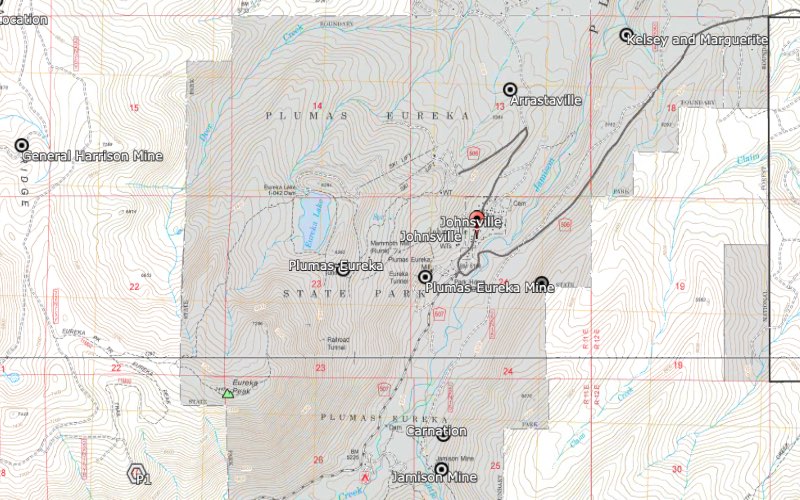By A. H. KOSCHMANN and M. H. BERGENDAHL - USGS 1968
Click here for the Principle Gold Producing Districts of the United States Index
Related: Plumas County, California Mines
Placer deposits in the Tertiary gravels in Plumas County were worked on a large scale by hydraulic methods in the early years. The peak production was during 1855-71, when at least $60 million (about 2,912,000 ounces) in gold was shipped from the La Porte district alone (Lindgren, 1911, p. 103). Lode mines also were developed at an early date, especially in the Johnsville district where some mines were active as early as 1851.
Recorded gold production of Plumas County from 1880 through 1959 was 1,670,000 ounces. Adding to this Lindgren's estimated $60 million from the La Porte district, the total from 1855 through 1959 was about 4,582,000 ounces.
The geology of Plumas County was described by Averill (1937, p. 82-88). In brief, the rocks consist of a series of sedimentary, metasedimentary, and metavolcanic formations that have been folded, faulted, and intruded by granodiorite of Late Jurassic and mid-Cretaceous age. Most of the western two-thirds of the county is underlain by northwest-trending bands of these folded rocks; the granodiorite occupies the eastern part.
The oldest rock in the county is metarhyolite which is overlain by quartzite and shale of the Grizzly Formation of Silurian age. The remainder of the stratified rocks, in ascending order, are the Montgomery Limestone of Silurian age, the Tay-lorsville Formation of Devonian age, the Calaveras Formation of Carboniferous age, the Hosselkus Limestone and Swearinger Slate of Triassic age, and seven other sedimentary formations of Early and Middle Jurassic age. Patches of Tertiary gravels mark the northward-trending course of the ancient Jura River and the northeasterly course of the Tertiary Yuba River.
Igneous rocks, in addition to those already mentioned, consist of basic flows and dikes of Carboniferous age, peridotite and pyroxenite bodies of Jurassic age, and greenstones, amphibolites, and metadiorites of Jurassic age. The northwest and large areas of the southeast and southwest parts of the county are covered by rhyolite, dacite, andesite, and basalt lava flows of Tertiary and Quaternary age.
CRESCENT MILLS DISTRICT
The Crescent Mills district, in T. 26 N., R. 9 E., has produced chiefly lode gold, but a small output has also been derived from Quaternary gravel deposits. The major mine in this district is the Green Mountain, with a production of between $1 and $2 million in gold to 1890 (Averill, 1937, p. Ill). From 1933 to 1952 the district produced 32,069 ounces of lode gold and 3,255 ounces of placer gold; no production was reported during 1952-59. Total minimum production through 1959 was about 100,000 ounces.
The bedrock in the southwest part of the district consists of a northwest-trending band of metasedimentary rocks of the Calaveras Formation. This is bordered on the northeast by a parallel band of pre-Devonian metavolcanic rocks. A few small bodies of granodiorite, of Jurassic age, cut the older rocks. The ore deposits are in veins in the metavolcanic rocks near the granodiorite and in the granodiorite itself. The veins consist of quartz with free gold and small amounts of sulfides.
JOHNSVILLE DISTRICT
The Johnsville, in the east half of T. 22 N., R. 11 E., in south-central Plumas County, is primarily a lode district, but it has produced some placer gold from Tertiary and possibly also from Quaternary gravels.

The Plumas Eureka mine, the largest lode mine in the district, began operations in 1851 and had a total estimated yield of $8 million in gold to about 1925 (Averill, 1937, p. 118). In more recent years the district has been only sporadically active; during 1933-59, only 2,009 ounces of lode gold and 1,413 ounces of placer gold were reported. Its total gold production was about 393,000 ounces.
The bedrock in the district consists of a broad northwest-trending band of metasedimentary rocks which belong to the Calaveras Formation of Carboniferous age (Averill, 1937, map) and which are intruded by small bodies of andesite of Carboniferous age. The gold deposits are in the quartz veins in the metasedimentary rocks.
LA PORTE DISTRICT
The La Porte district, in T. 21 N., R. 9 E., in southwest Plumas County, was the center of hydraulic mining of gravels of the Tertiary Yuba River in the 1850's and 1860's. After the enactment of debris control laws, the gravels were worked by drift mines on a much-reduced scale. During 1932-59 the district produced 9,347 ounces of gold. Total production from 1855 through 1959 was about 2,910,000 ounces. A small amount of production was reported in 1957, but none was reported in 1958-59.
The channel near La Porte is about 500 feet wide. Gold was concentrated on the amphibolite bedrock or in the lowermost 2 feet of the gravel. The main channel has been traced a distance of 10 miles to the northeast, and it ranges from 500 to 1,500 feet in width and from 14 to 129 feet in depth. The channel is offset near La Porte by numerous faults which have an aggregate displacement of about 500 feet (Lindgren, 1911, p. 105-108).